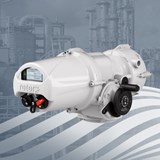Rotork recently launched their IQT Shutdown Battery to provide further operational flexibility to the IQT3 range of part-turn 1-phase, 3-phase and DC electric actuators with the addition of a new integral battery option that provides fail-to-position functionality in explosionproof applications.
This pre-programmed movement of the valve on loss of power or communications means customers retain important control over their operations during a power outage or Emergency Shut-Down (ESD). A lithium-ion battery supplies the potentially vital backup power from within the actuator enclosure. The integral battery pack provides a compact, explosionproof shutdown solution.
In the event of main power loss, the Shutdown Battery can continue to function automatically to a site configurable end of travel safe position, providing fail-to-position functionality on critical valves. The failure mode can change depending on customer requirements. This fail-to-position can be fail-closed, open, stayput or go-to-a-per-cent position, depending on what fail-to-position action is needed to ensure the process fails to a safe operating state. This means the process finishes in a safe operating state, preventing any safety issues and avoiding monetary consequences due to loss of control. With the Shutdown Battery there is no need for additional back-up systems, such as compressors, to provide this functionality.
The IQT Shutdown Battery also features an Uninterruptible Power Supply (UPS) mode. This ensures that there is continued control and operation of the actuator on loss of mains power until the battery charge has run out. Operations can continue as normal while the battery charge lasts, mitigating the risk of deferred or lost revenue due to power outages.
The IQT Shutdown Battery is ideal for control valves, blow down valves and control process applications which must be shut down in a phased or staged sequence. It is also suited for the transfer of crude oil and valves at often unmanned natural gas custody transfer stations, where valves should ‘fail-to-divert’ process fluid back to the storage tanks on loss of power.
Image credit: Rotork


